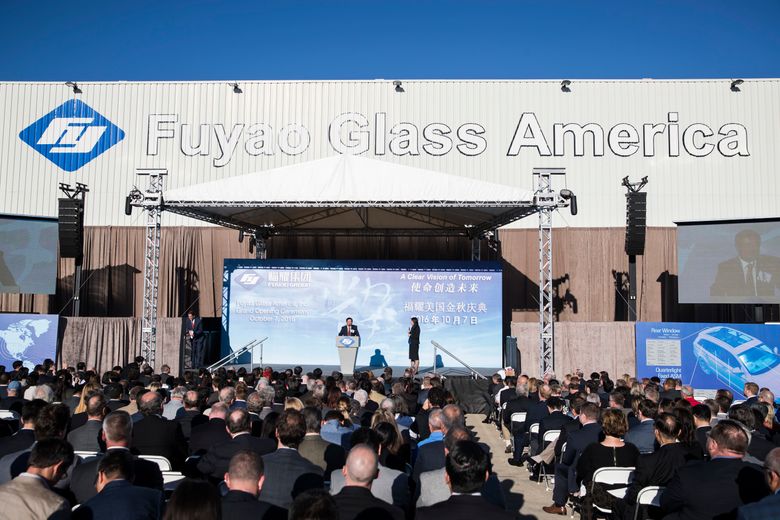The Seattle Times
A union body blow in what was once an organized-labor bastion
 Cho Tak Wong, chairman of the Fuyao Group, speaks during the grand opening of the Fuyao Glass America plant, Friday, Oct. 7, 2016, in Moraine, Ohio. The Chinese company’s completed automotive glass-making plant serves as its North American hub for recycled glass manufacturing. (AP Photo/John Minchillo)
Cho Tak Wong, chairman of the Fuyao Group, speaks during the grand opening of the Fuyao Glass America plant, Friday, Oct. 7, 2016, in Moraine, Ohio. The Chinese company’s completed automotive glass-making plant serves as its North American hub for recycled glass manufacturing. (AP Photo/John Minchillo)
A critical loss for organized labor shows the economic angst of the Heartland is more complicated.
By Jon Talton, Special to The Seatle Times December 7, 2017
One of the tropes of the 2016 election was that the white working class felt slighted by globalization and voted heavily for the “populism” of Donald Trump. And perhaps that — instead of white-identity and culture-war issues — drove at least some. But in the Heartland, where Trumpism gained heavily, the messages are mixed.
Last month, employees at Fuyao Glass America in suburban Dayton, Ohio, voted by a wide margin to reject joining the United Auto Workers. The factory, which makes auto glass, is located in the shell of the former General Motors Moraine Assembly (and the reader should know I was the business editor at the Dayton Daily News from 1986-1990). The “no” vote represents a stunning turnaround for organized labor.
From 1951 to 1979, this factory made appliances for Frigidaire, a GM subsidiary. When the appliance manufacturing operation was shut down, the plant was saved by a collaboration among state and local government, GM, and the union. With big tax breaks and an adaptable local union, it was transformed into an auto assembly plant, turning out the popular small S-10 Blazer SUV. It was the only GM assembly represented by the International Brotherhood of Electrical Workers, a holdover from Frigidaire days.
This is part of the Rust Belt story that’s rarely told: How the region reinvented itself after catastrophic losses in the late 1970s and early 1980. Dayton was no stranger to this: When NCR ended manufacturing of mechanical cash registers, it cost some 30,000 good local jobs and left a swath south of downtown empty as former factories were torn down. But often places were able to adapt, even with the headwinds of ’80s-style vulture capitalism.
Moraine was one of the success stories. And the union was essential. Often its members had the best ideas to improve productivity and innovation — the bottleneck was then-CEO Roger Smith’s bureaucracy. Unions were still popular — people understood that, even with their flaws, they had been essential to building the middle class and spreading benefits across workplaces everywhere. In 1989, more than 21 percent of Ohio workers were union members. By 2016, it was 12.4 percent. Nationally, only 6.4 percent of the private-sector workforce was unionized last year, compared to more than one-third in the 1950s.
The Moraine Assembly was shut down by GM in 2008. Automation, moves to non-union plants in the South, and China’s rise in the world economy have cost Ohio 376,000 manufacturing jobs since 1990. Fuyao, paradoxically, is a Chinese company, one of a small number that have opened factories in the United States. In the New York Times, Cao Dewang, the company’s founder, blamed “excessive union power for American industrial decline” and said, “To be brutally honest, up to this moment, my investment in the U.S. has brought no good to Fuyao.”
Don’t be a sore winner.
In reality, the decline of unions goes far beyond their sometime corruption or overreaching (and that never happens with businesses, right?). Blame the savaging of key industries by decades of “rip, strip and flip” capitalism, weak antitrust enforcement, deregulation and anti-worker bias on the National Labor Relations Board and elsewhere in the federal government. Globalization played a role, but unions are strong in Germany. America’s story is more complicated.
One of the chapters is about workers voting against their self-interest. How many at Fuyao voted for Trump? They got the wealthiest cabinet in history, more deregulation and hostility to workers, and soon tax legislation that will cause lasting damage to the middle class. “Great Again,” in the minds of Trump voters, was the Nifty Fifties. But apparently without the strong unions.
